Significance and Essentials of Management Accounting Systems
VerifiedAdded on 2023/01/19
|18
|4601
|63
AI Summary
This report discusses the significance and essentials of different management accounting systems, such as cost accounting system, price optimization system, job costing system, and inventory management system. It also describes the different methods used for reporting, including budget reports, receivable reports, cost accounting reports, and performance reports. Additionally, it evaluates the benefits and applications of these systems and discusses different planning tools used under budgetary control.
Contribute Materials
Your contribution can guide someone’s learning journey. Share your
documents today.

MANAGEMENT
ACCOUNTING
ACCOUNTING
Secure Best Marks with AI Grader
Need help grading? Try our AI Grader for instant feedback on your assignments.
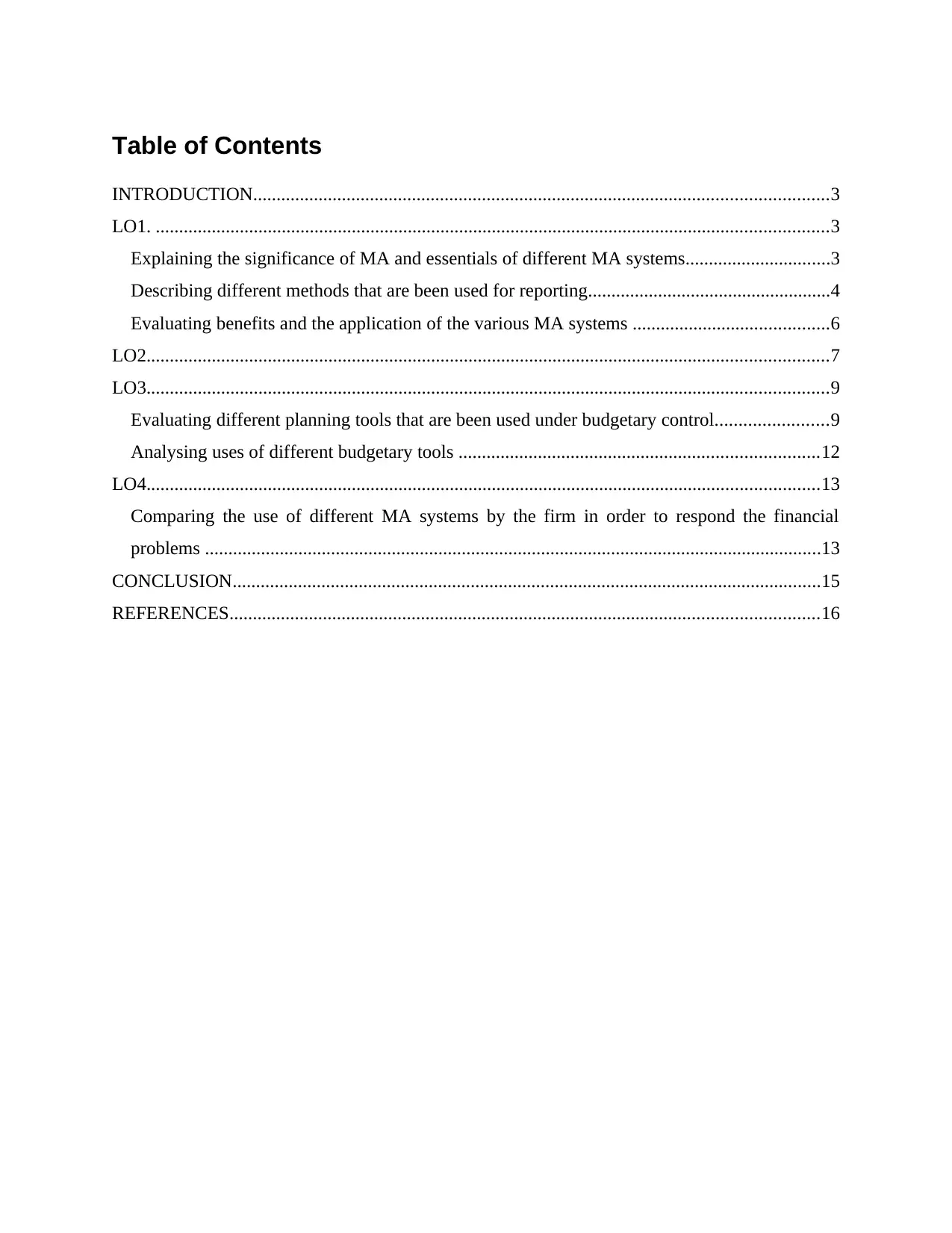
Table of Contents
INTRODUCTION...........................................................................................................................3
LO1. ................................................................................................................................................3
Explaining the significance of MA and essentials of different MA systems...............................3
Describing different methods that are been used for reporting....................................................4
Evaluating benefits and the application of the various MA systems ..........................................6
LO2..................................................................................................................................................7
LO3..................................................................................................................................................9
Evaluating different planning tools that are been used under budgetary control........................9
Analysing uses of different budgetary tools .............................................................................12
LO4................................................................................................................................................13
Comparing the use of different MA systems by the firm in order to respond the financial
problems ....................................................................................................................................13
CONCLUSION..............................................................................................................................15
REFERENCES..............................................................................................................................16
INTRODUCTION...........................................................................................................................3
LO1. ................................................................................................................................................3
Explaining the significance of MA and essentials of different MA systems...............................3
Describing different methods that are been used for reporting....................................................4
Evaluating benefits and the application of the various MA systems ..........................................6
LO2..................................................................................................................................................7
LO3..................................................................................................................................................9
Evaluating different planning tools that are been used under budgetary control........................9
Analysing uses of different budgetary tools .............................................................................12
LO4................................................................................................................................................13
Comparing the use of different MA systems by the firm in order to respond the financial
problems ....................................................................................................................................13
CONCLUSION..............................................................................................................................15
REFERENCES..............................................................................................................................16
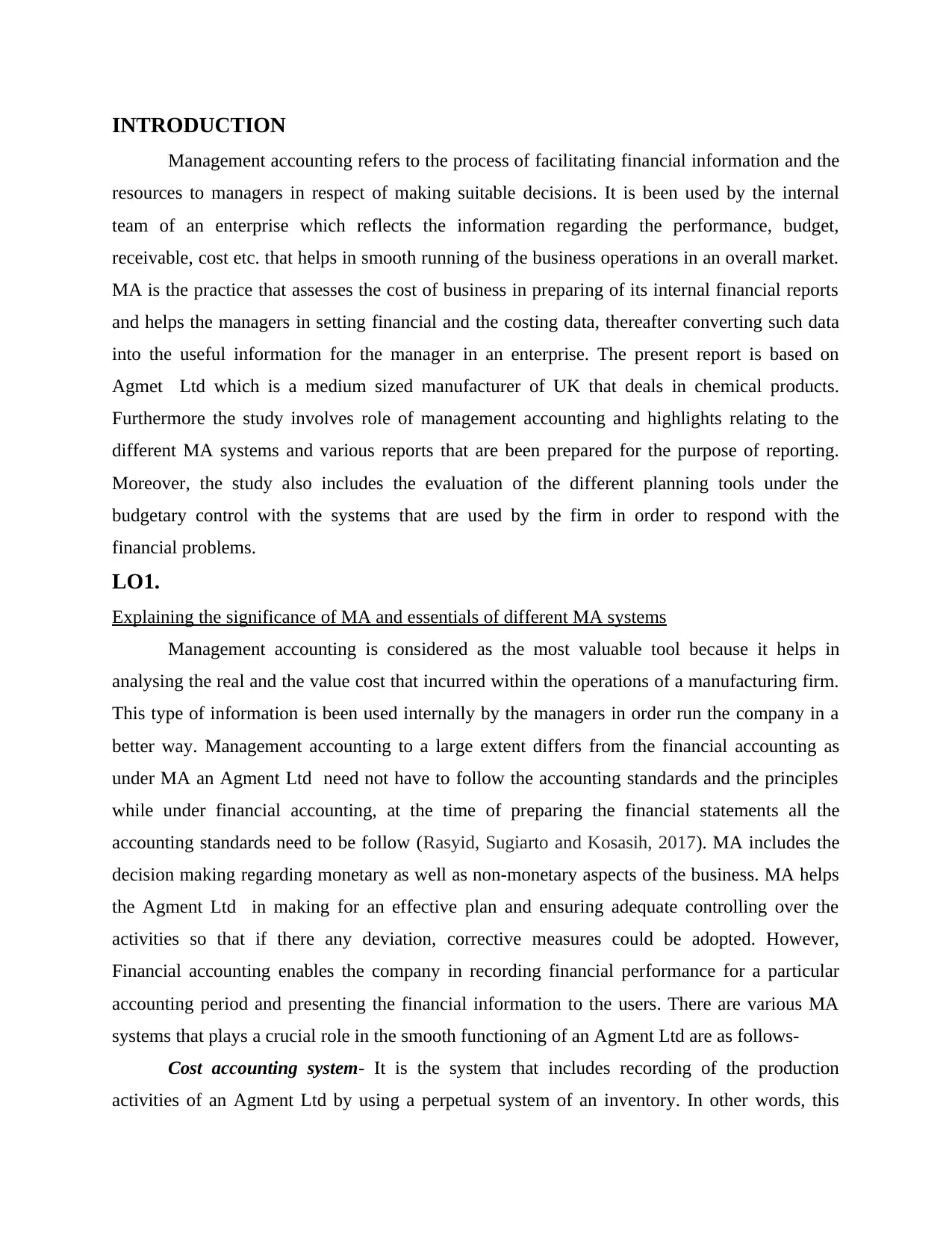
INTRODUCTION
Management accounting refers to the process of facilitating financial information and the
resources to managers in respect of making suitable decisions. It is been used by the internal
team of an enterprise which reflects the information regarding the performance, budget,
receivable, cost etc. that helps in smooth running of the business operations in an overall market.
MA is the practice that assesses the cost of business in preparing of its internal financial reports
and helps the managers in setting financial and the costing data, thereafter converting such data
into the useful information for the manager in an enterprise. The present report is based on
Agmet Ltd which is a medium sized manufacturer of UK that deals in chemical products.
Furthermore the study involves role of management accounting and highlights relating to the
different MA systems and various reports that are been prepared for the purpose of reporting.
Moreover, the study also includes the evaluation of the different planning tools under the
budgetary control with the systems that are used by the firm in order to respond with the
financial problems.
LO1.
Explaining the significance of MA and essentials of different MA systems
Management accounting is considered as the most valuable tool because it helps in
analysing the real and the value cost that incurred within the operations of a manufacturing firm.
This type of information is been used internally by the managers in order run the company in a
better way. Management accounting to a large extent differs from the financial accounting as
under MA an Agment Ltd need not have to follow the accounting standards and the principles
while under financial accounting, at the time of preparing the financial statements all the
accounting standards need to be follow (Rasyid, Sugiarto and Kosasih, 2017). MA includes the
decision making regarding monetary as well as non-monetary aspects of the business. MA helps
the Agment Ltd in making for an effective plan and ensuring adequate controlling over the
activities so that if there any deviation, corrective measures could be adopted. However,
Financial accounting enables the company in recording financial performance for a particular
accounting period and presenting the financial information to the users. There are various MA
systems that plays a crucial role in the smooth functioning of an Agment Ltd are as follows-
Cost accounting system- It is the system that includes recording of the production
activities of an Agment Ltd by using a perpetual system of an inventory. In other words, this
Management accounting refers to the process of facilitating financial information and the
resources to managers in respect of making suitable decisions. It is been used by the internal
team of an enterprise which reflects the information regarding the performance, budget,
receivable, cost etc. that helps in smooth running of the business operations in an overall market.
MA is the practice that assesses the cost of business in preparing of its internal financial reports
and helps the managers in setting financial and the costing data, thereafter converting such data
into the useful information for the manager in an enterprise. The present report is based on
Agmet Ltd which is a medium sized manufacturer of UK that deals in chemical products.
Furthermore the study involves role of management accounting and highlights relating to the
different MA systems and various reports that are been prepared for the purpose of reporting.
Moreover, the study also includes the evaluation of the different planning tools under the
budgetary control with the systems that are used by the firm in order to respond with the
financial problems.
LO1.
Explaining the significance of MA and essentials of different MA systems
Management accounting is considered as the most valuable tool because it helps in
analysing the real and the value cost that incurred within the operations of a manufacturing firm.
This type of information is been used internally by the managers in order run the company in a
better way. Management accounting to a large extent differs from the financial accounting as
under MA an Agment Ltd need not have to follow the accounting standards and the principles
while under financial accounting, at the time of preparing the financial statements all the
accounting standards need to be follow (Rasyid, Sugiarto and Kosasih, 2017). MA includes the
decision making regarding monetary as well as non-monetary aspects of the business. MA helps
the Agment Ltd in making for an effective plan and ensuring adequate controlling over the
activities so that if there any deviation, corrective measures could be adopted. However,
Financial accounting enables the company in recording financial performance for a particular
accounting period and presenting the financial information to the users. There are various MA
systems that plays a crucial role in the smooth functioning of an Agment Ltd are as follows-
Cost accounting system- It is the system that includes recording of the production
activities of an Agment Ltd by using a perpetual system of an inventory. In other words, this
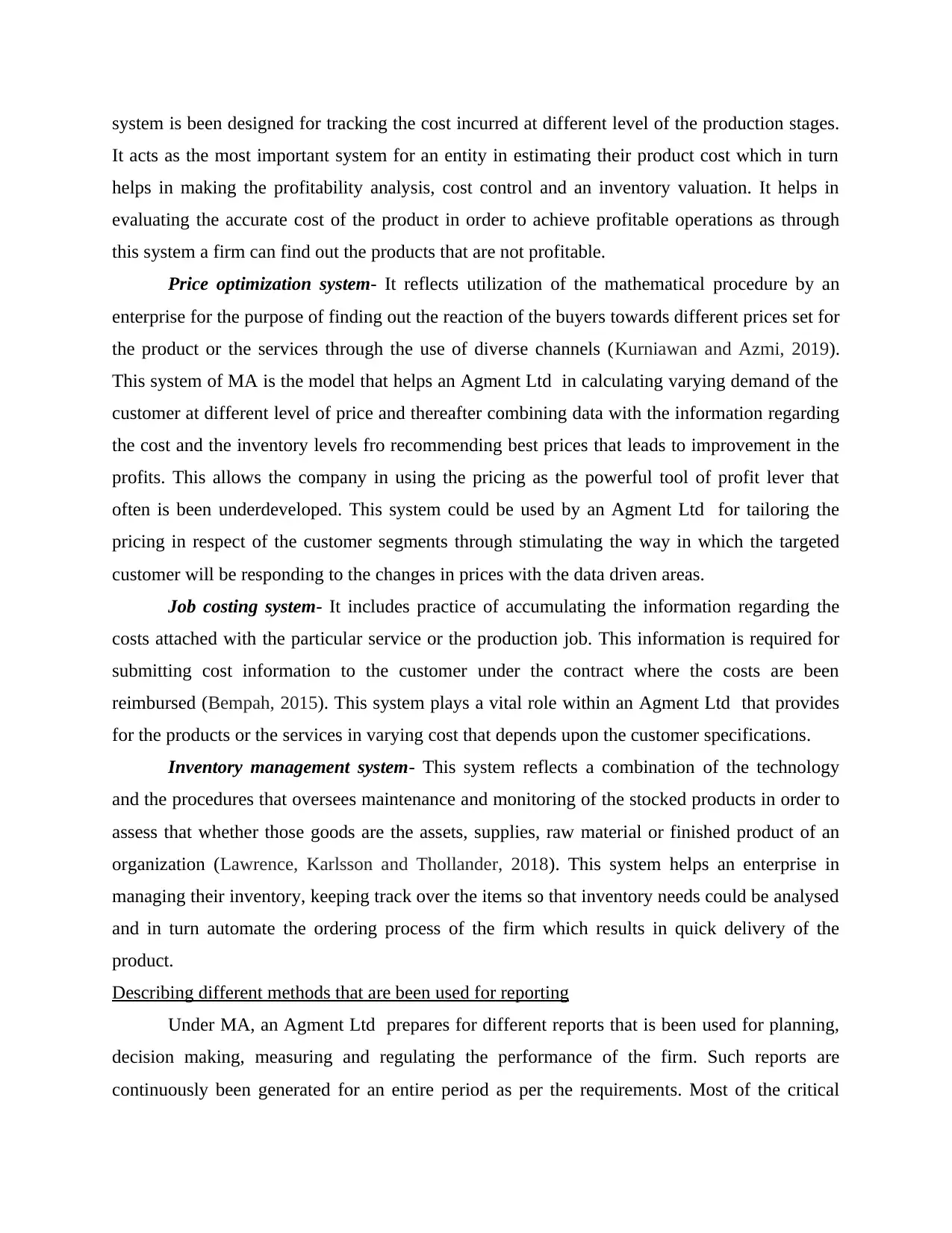
system is been designed for tracking the cost incurred at different level of the production stages.
It acts as the most important system for an entity in estimating their product cost which in turn
helps in making the profitability analysis, cost control and an inventory valuation. It helps in
evaluating the accurate cost of the product in order to achieve profitable operations as through
this system a firm can find out the products that are not profitable.
Price optimization system- It reflects utilization of the mathematical procedure by an
enterprise for the purpose of finding out the reaction of the buyers towards different prices set for
the product or the services through the use of diverse channels (Kurniawan and Azmi, 2019).
This system of MA is the model that helps an Agment Ltd in calculating varying demand of the
customer at different level of price and thereafter combining data with the information regarding
the cost and the inventory levels fro recommending best prices that leads to improvement in the
profits. This allows the company in using the pricing as the powerful tool of profit lever that
often is been underdeveloped. This system could be used by an Agment Ltd for tailoring the
pricing in respect of the customer segments through stimulating the way in which the targeted
customer will be responding to the changes in prices with the data driven areas.
Job costing system- It includes practice of accumulating the information regarding the
costs attached with the particular service or the production job. This information is required for
submitting cost information to the customer under the contract where the costs are been
reimbursed (Bempah, 2015). This system plays a vital role within an Agment Ltd that provides
for the products or the services in varying cost that depends upon the customer specifications.
Inventory management system- This system reflects a combination of the technology
and the procedures that oversees maintenance and monitoring of the stocked products in order to
assess that whether those goods are the assets, supplies, raw material or finished product of an
organization (Lawrence, Karlsson and Thollander, 2018). This system helps an enterprise in
managing their inventory, keeping track over the items so that inventory needs could be analysed
and in turn automate the ordering process of the firm which results in quick delivery of the
product.
Describing different methods that are been used for reporting
Under MA, an Agment Ltd prepares for different reports that is been used for planning,
decision making, measuring and regulating the performance of the firm. Such reports are
continuously been generated for an entire period as per the requirements. Most of the critical
It acts as the most important system for an entity in estimating their product cost which in turn
helps in making the profitability analysis, cost control and an inventory valuation. It helps in
evaluating the accurate cost of the product in order to achieve profitable operations as through
this system a firm can find out the products that are not profitable.
Price optimization system- It reflects utilization of the mathematical procedure by an
enterprise for the purpose of finding out the reaction of the buyers towards different prices set for
the product or the services through the use of diverse channels (Kurniawan and Azmi, 2019).
This system of MA is the model that helps an Agment Ltd in calculating varying demand of the
customer at different level of price and thereafter combining data with the information regarding
the cost and the inventory levels fro recommending best prices that leads to improvement in the
profits. This allows the company in using the pricing as the powerful tool of profit lever that
often is been underdeveloped. This system could be used by an Agment Ltd for tailoring the
pricing in respect of the customer segments through stimulating the way in which the targeted
customer will be responding to the changes in prices with the data driven areas.
Job costing system- It includes practice of accumulating the information regarding the
costs attached with the particular service or the production job. This information is required for
submitting cost information to the customer under the contract where the costs are been
reimbursed (Bempah, 2015). This system plays a vital role within an Agment Ltd that provides
for the products or the services in varying cost that depends upon the customer specifications.
Inventory management system- This system reflects a combination of the technology
and the procedures that oversees maintenance and monitoring of the stocked products in order to
assess that whether those goods are the assets, supplies, raw material or finished product of an
organization (Lawrence, Karlsson and Thollander, 2018). This system helps an enterprise in
managing their inventory, keeping track over the items so that inventory needs could be analysed
and in turn automate the ordering process of the firm which results in quick delivery of the
product.
Describing different methods that are been used for reporting
Under MA, an Agment Ltd prepares for different reports that is been used for planning,
decision making, measuring and regulating the performance of the firm. Such reports are
continuously been generated for an entire period as per the requirements. Most of the critical
Secure Best Marks with AI Grader
Need help grading? Try our AI Grader for instant feedback on your assignments.
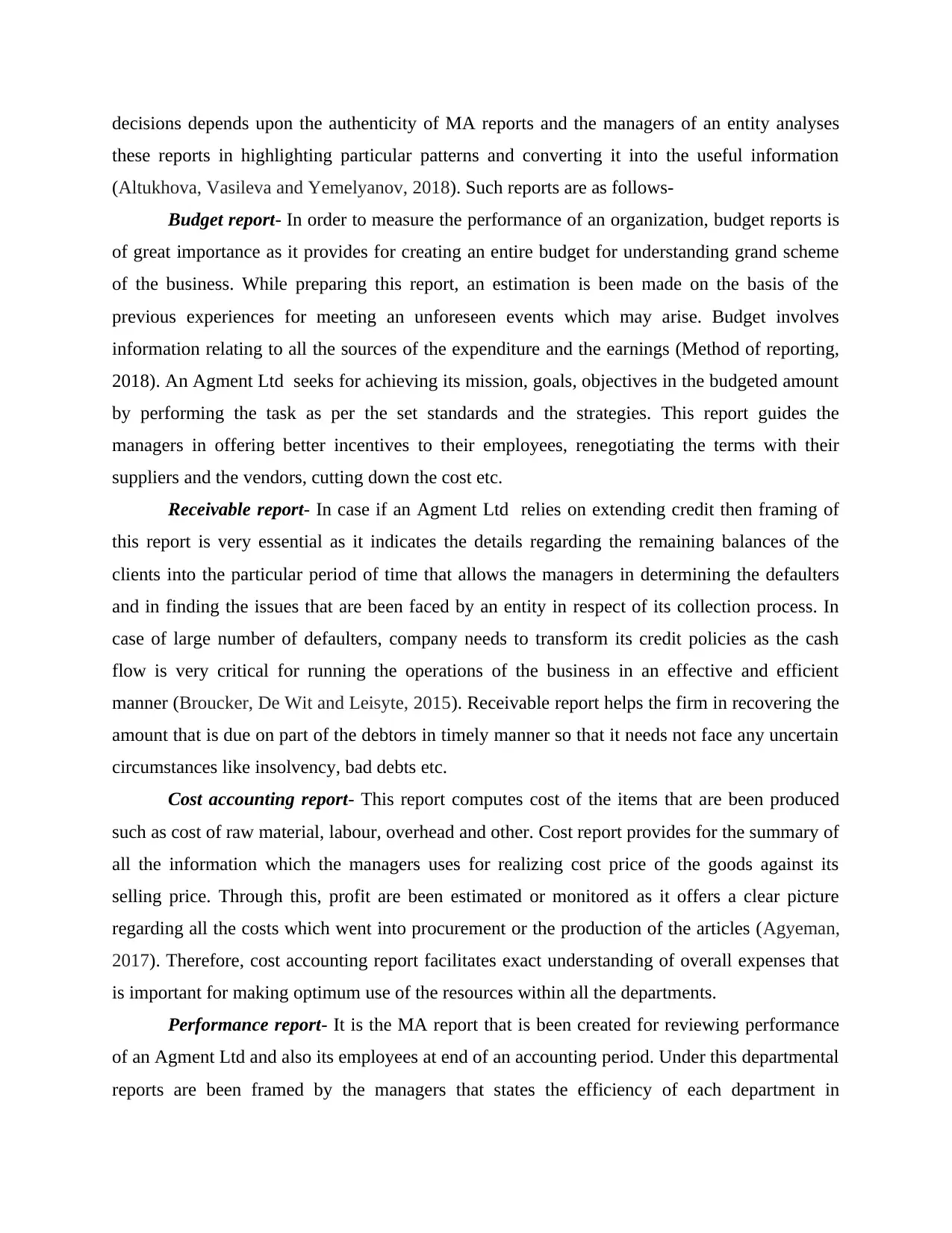
decisions depends upon the authenticity of MA reports and the managers of an entity analyses
these reports in highlighting particular patterns and converting it into the useful information
(Altukhova, Vasileva and Yemelyanov, 2018). Such reports are as follows-
Budget report- In order to measure the performance of an organization, budget reports is
of great importance as it provides for creating an entire budget for understanding grand scheme
of the business. While preparing this report, an estimation is been made on the basis of the
previous experiences for meeting an unforeseen events which may arise. Budget involves
information relating to all the sources of the expenditure and the earnings (Method of reporting,
2018). An Agment Ltd seeks for achieving its mission, goals, objectives in the budgeted amount
by performing the task as per the set standards and the strategies. This report guides the
managers in offering better incentives to their employees, renegotiating the terms with their
suppliers and the vendors, cutting down the cost etc.
Receivable report- In case if an Agment Ltd relies on extending credit then framing of
this report is very essential as it indicates the details regarding the remaining balances of the
clients into the particular period of time that allows the managers in determining the defaulters
and in finding the issues that are been faced by an entity in respect of its collection process. In
case of large number of defaulters, company needs to transform its credit policies as the cash
flow is very critical for running the operations of the business in an effective and efficient
manner (Broucker, De Wit and Leisyte, 2015). Receivable report helps the firm in recovering the
amount that is due on part of the debtors in timely manner so that it needs not face any uncertain
circumstances like insolvency, bad debts etc.
Cost accounting report- This report computes cost of the items that are been produced
such as cost of raw material, labour, overhead and other. Cost report provides for the summary of
all the information which the managers uses for realizing cost price of the goods against its
selling price. Through this, profit are been estimated or monitored as it offers a clear picture
regarding all the costs which went into procurement or the production of the articles (Agyeman,
2017). Therefore, cost accounting report facilitates exact understanding of overall expenses that
is important for making optimum use of the resources within all the departments.
Performance report- It is the MA report that is been created for reviewing performance
of an Agment Ltd and also its employees at end of an accounting period. Under this departmental
reports are been framed by the managers that states the efficiency of each department in
these reports in highlighting particular patterns and converting it into the useful information
(Altukhova, Vasileva and Yemelyanov, 2018). Such reports are as follows-
Budget report- In order to measure the performance of an organization, budget reports is
of great importance as it provides for creating an entire budget for understanding grand scheme
of the business. While preparing this report, an estimation is been made on the basis of the
previous experiences for meeting an unforeseen events which may arise. Budget involves
information relating to all the sources of the expenditure and the earnings (Method of reporting,
2018). An Agment Ltd seeks for achieving its mission, goals, objectives in the budgeted amount
by performing the task as per the set standards and the strategies. This report guides the
managers in offering better incentives to their employees, renegotiating the terms with their
suppliers and the vendors, cutting down the cost etc.
Receivable report- In case if an Agment Ltd relies on extending credit then framing of
this report is very essential as it indicates the details regarding the remaining balances of the
clients into the particular period of time that allows the managers in determining the defaulters
and in finding the issues that are been faced by an entity in respect of its collection process. In
case of large number of defaulters, company needs to transform its credit policies as the cash
flow is very critical for running the operations of the business in an effective and efficient
manner (Broucker, De Wit and Leisyte, 2015). Receivable report helps the firm in recovering the
amount that is due on part of the debtors in timely manner so that it needs not face any uncertain
circumstances like insolvency, bad debts etc.
Cost accounting report- This report computes cost of the items that are been produced
such as cost of raw material, labour, overhead and other. Cost report provides for the summary of
all the information which the managers uses for realizing cost price of the goods against its
selling price. Through this, profit are been estimated or monitored as it offers a clear picture
regarding all the costs which went into procurement or the production of the articles (Agyeman,
2017). Therefore, cost accounting report facilitates exact understanding of overall expenses that
is important for making optimum use of the resources within all the departments.
Performance report- It is the MA report that is been created for reviewing performance
of an Agment Ltd and also its employees at end of an accounting period. Under this departmental
reports are been framed by the managers that states the efficiency of each department in
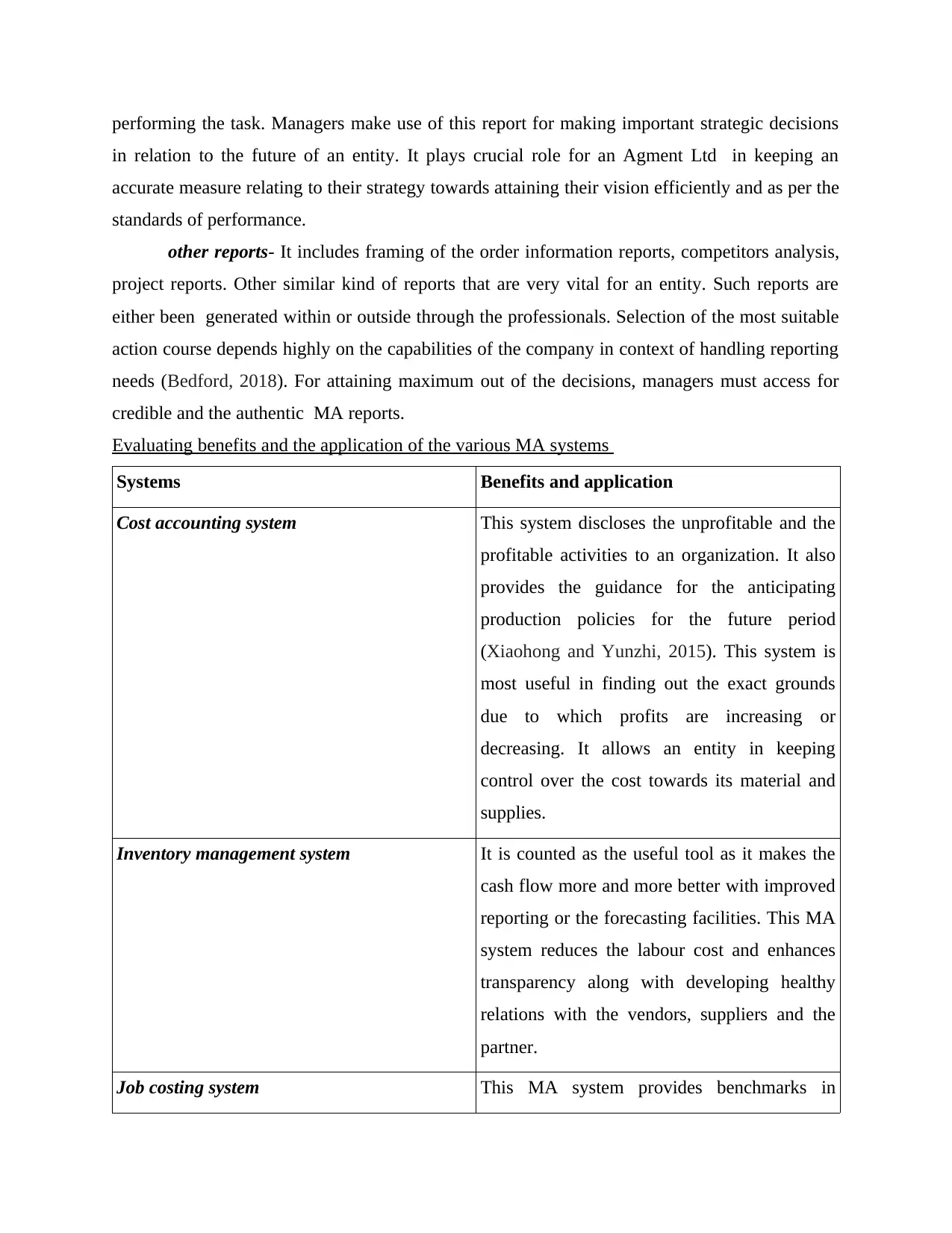
performing the task. Managers make use of this report for making important strategic decisions
in relation to the future of an entity. It plays crucial role for an Agment Ltd in keeping an
accurate measure relating to their strategy towards attaining their vision efficiently and as per the
standards of performance.
other reports- It includes framing of the order information reports, competitors analysis,
project reports. Other similar kind of reports that are very vital for an entity. Such reports are
either been generated within or outside through the professionals. Selection of the most suitable
action course depends highly on the capabilities of the company in context of handling reporting
needs (Bedford, 2018). For attaining maximum out of the decisions, managers must access for
credible and the authentic MA reports.
Evaluating benefits and the application of the various MA systems
Systems Benefits and application
Cost accounting system This system discloses the unprofitable and the
profitable activities to an organization. It also
provides the guidance for the anticipating
production policies for the future period
(Xiaohong and Yunzhi, 2015). This system is
most useful in finding out the exact grounds
due to which profits are increasing or
decreasing. It allows an entity in keeping
control over the cost towards its material and
supplies.
Inventory management system It is counted as the useful tool as it makes the
cash flow more and more better with improved
reporting or the forecasting facilities. This MA
system reduces the labour cost and enhances
transparency along with developing healthy
relations with the vendors, suppliers and the
partner.
Job costing system This MA system provides benchmarks in
in relation to the future of an entity. It plays crucial role for an Agment Ltd in keeping an
accurate measure relating to their strategy towards attaining their vision efficiently and as per the
standards of performance.
other reports- It includes framing of the order information reports, competitors analysis,
project reports. Other similar kind of reports that are very vital for an entity. Such reports are
either been generated within or outside through the professionals. Selection of the most suitable
action course depends highly on the capabilities of the company in context of handling reporting
needs (Bedford, 2018). For attaining maximum out of the decisions, managers must access for
credible and the authentic MA reports.
Evaluating benefits and the application of the various MA systems
Systems Benefits and application
Cost accounting system This system discloses the unprofitable and the
profitable activities to an organization. It also
provides the guidance for the anticipating
production policies for the future period
(Xiaohong and Yunzhi, 2015). This system is
most useful in finding out the exact grounds
due to which profits are increasing or
decreasing. It allows an entity in keeping
control over the cost towards its material and
supplies.
Inventory management system It is counted as the useful tool as it makes the
cash flow more and more better with improved
reporting or the forecasting facilities. This MA
system reduces the labour cost and enhances
transparency along with developing healthy
relations with the vendors, suppliers and the
partner.
Job costing system This MA system provides benchmarks in
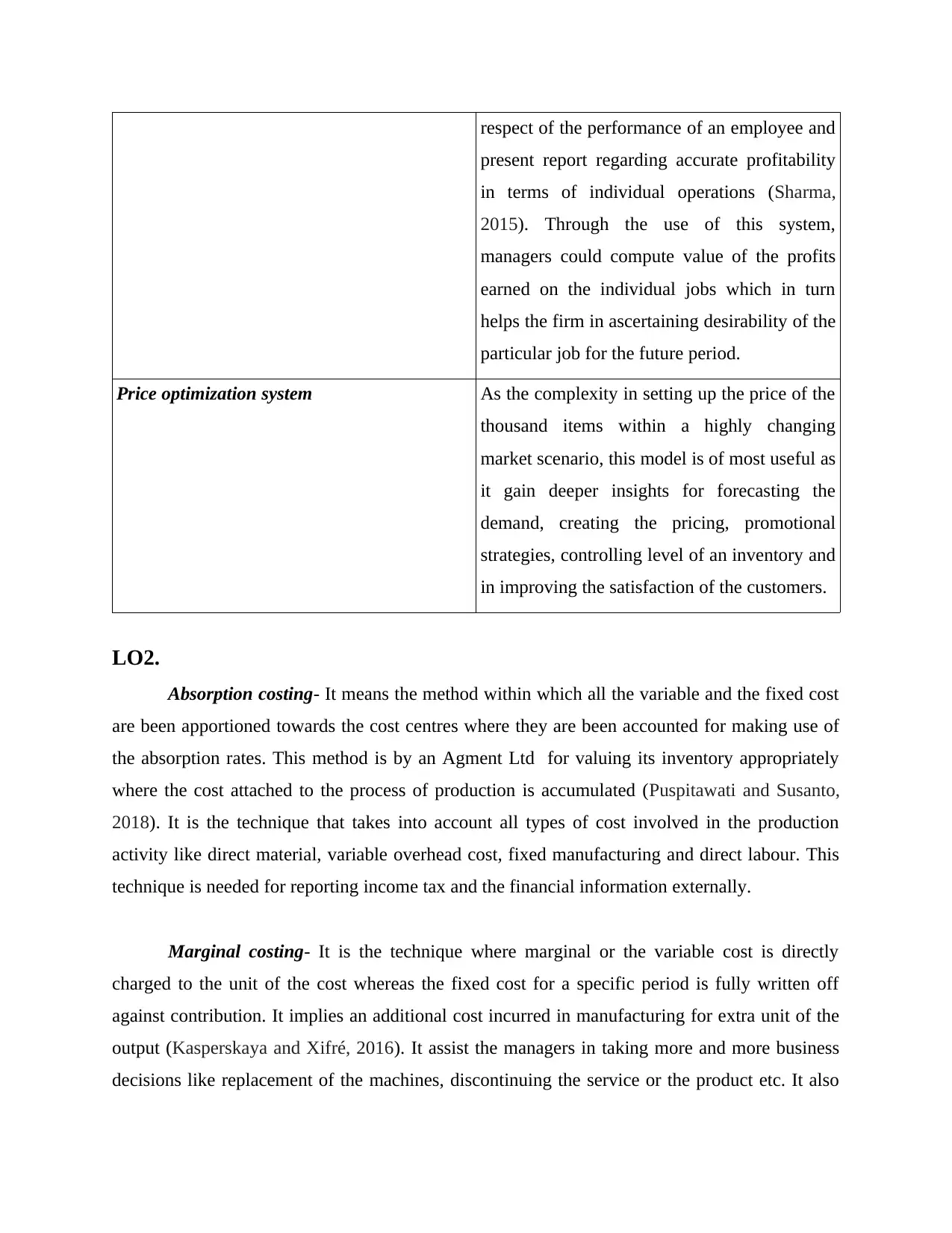
respect of the performance of an employee and
present report regarding accurate profitability
in terms of individual operations (Sharma,
2015). Through the use of this system,
managers could compute value of the profits
earned on the individual jobs which in turn
helps the firm in ascertaining desirability of the
particular job for the future period.
Price optimization system As the complexity in setting up the price of the
thousand items within a highly changing
market scenario, this model is of most useful as
it gain deeper insights for forecasting the
demand, creating the pricing, promotional
strategies, controlling level of an inventory and
in improving the satisfaction of the customers.
LO2.
Absorption costing- It means the method within which all the variable and the fixed cost
are been apportioned towards the cost centres where they are been accounted for making use of
the absorption rates. This method is by an Agment Ltd for valuing its inventory appropriately
where the cost attached to the process of production is accumulated (Puspitawati and Susanto,
2018). It is the technique that takes into account all types of cost involved in the production
activity like direct material, variable overhead cost, fixed manufacturing and direct labour. This
technique is needed for reporting income tax and the financial information externally.
Marginal costing- It is the technique where marginal or the variable cost is directly
charged to the unit of the cost whereas the fixed cost for a specific period is fully written off
against contribution. It implies an additional cost incurred in manufacturing for extra unit of the
output (Kasperskaya and Xifré, 2016). It assist the managers in taking more and more business
decisions like replacement of the machines, discontinuing the service or the product etc. It also
present report regarding accurate profitability
in terms of individual operations (Sharma,
2015). Through the use of this system,
managers could compute value of the profits
earned on the individual jobs which in turn
helps the firm in ascertaining desirability of the
particular job for the future period.
Price optimization system As the complexity in setting up the price of the
thousand items within a highly changing
market scenario, this model is of most useful as
it gain deeper insights for forecasting the
demand, creating the pricing, promotional
strategies, controlling level of an inventory and
in improving the satisfaction of the customers.
LO2.
Absorption costing- It means the method within which all the variable and the fixed cost
are been apportioned towards the cost centres where they are been accounted for making use of
the absorption rates. This method is by an Agment Ltd for valuing its inventory appropriately
where the cost attached to the process of production is accumulated (Puspitawati and Susanto,
2018). It is the technique that takes into account all types of cost involved in the production
activity like direct material, variable overhead cost, fixed manufacturing and direct labour. This
technique is needed for reporting income tax and the financial information externally.
Marginal costing- It is the technique where marginal or the variable cost is directly
charged to the unit of the cost whereas the fixed cost for a specific period is fully written off
against contribution. It implies an additional cost incurred in manufacturing for extra unit of the
output (Kasperskaya and Xifré, 2016). It assist the managers in taking more and more business
decisions like replacement of the machines, discontinuing the service or the product etc. It also
Paraphrase This Document
Need a fresh take? Get an instant paraphrase of this document with our AI Paraphraser
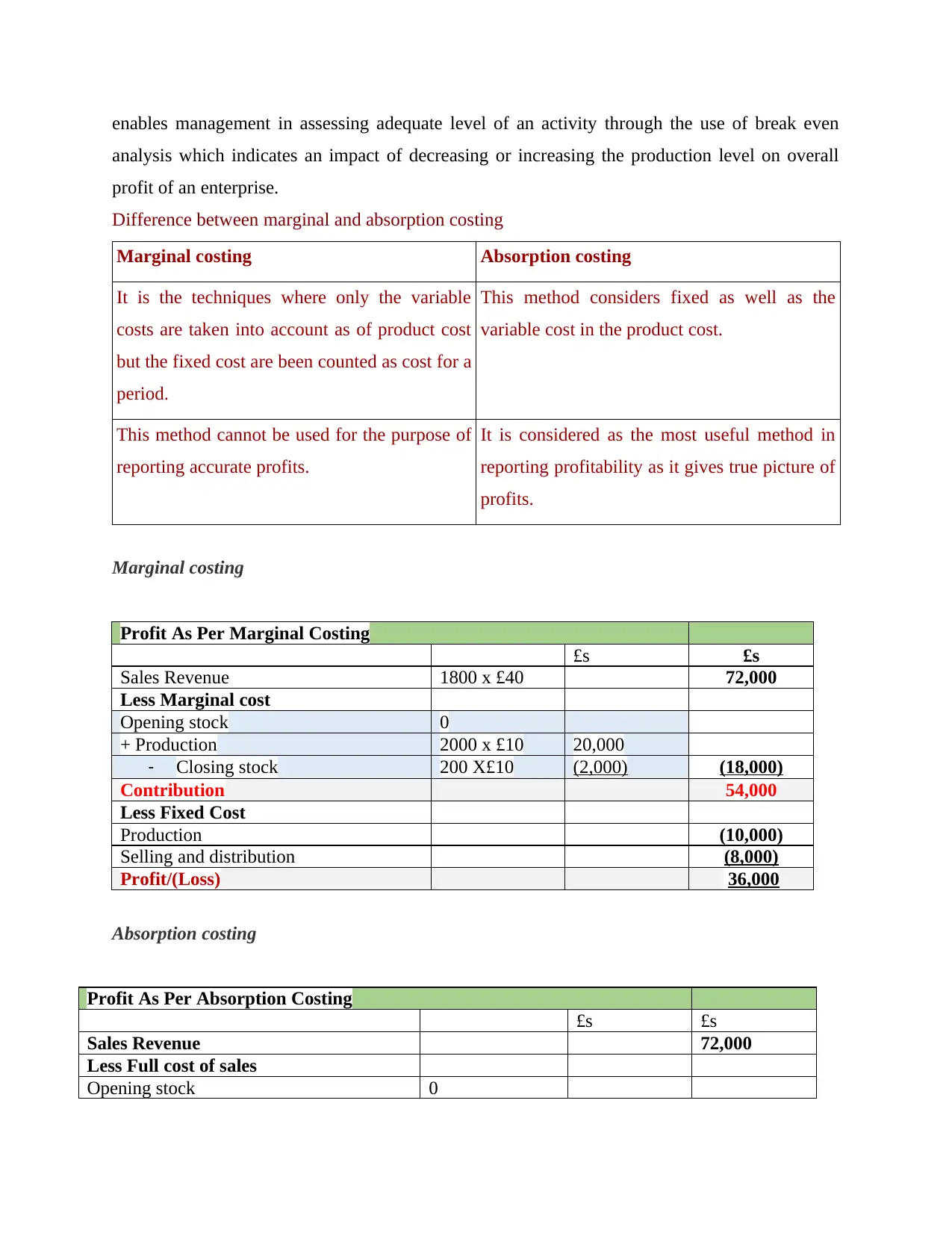
enables management in assessing adequate level of an activity through the use of break even
analysis which indicates an impact of decreasing or increasing the production level on overall
profit of an enterprise.
Difference between marginal and absorption costing
Marginal costing Absorption costing
It is the techniques where only the variable
costs are taken into account as of product cost
but the fixed cost are been counted as cost for a
period.
This method considers fixed as well as the
variable cost in the product cost.
This method cannot be used for the purpose of
reporting accurate profits.
It is considered as the most useful method in
reporting profitability as it gives true picture of
profits.
Marginal costing
Profit As Per Marginal Costing
£s £s
Sales Revenue 1800 x £40 72,000
Less Marginal cost
Opening stock 0
+ Production 2000 x £10 20,000
- Closing stock 200 X£10 (2,000) (18,000)
Contribution 54,000
Less Fixed Cost
Production (10,000)
Selling and distribution (8,000)
Profit/(Loss) 36,000
Absorption costing
Profit As Per Absorption Costing
£s £s
Sales Revenue 72,000
Less Full cost of sales
Opening stock 0
analysis which indicates an impact of decreasing or increasing the production level on overall
profit of an enterprise.
Difference between marginal and absorption costing
Marginal costing Absorption costing
It is the techniques where only the variable
costs are taken into account as of product cost
but the fixed cost are been counted as cost for a
period.
This method considers fixed as well as the
variable cost in the product cost.
This method cannot be used for the purpose of
reporting accurate profits.
It is considered as the most useful method in
reporting profitability as it gives true picture of
profits.
Marginal costing
Profit As Per Marginal Costing
£s £s
Sales Revenue 1800 x £40 72,000
Less Marginal cost
Opening stock 0
+ Production 2000 x £10 20,000
- Closing stock 200 X£10 (2,000) (18,000)
Contribution 54,000
Less Fixed Cost
Production (10,000)
Selling and distribution (8,000)
Profit/(Loss) 36,000
Absorption costing
Profit As Per Absorption Costing
£s £s
Sales Revenue 72,000
Less Full cost of sales
Opening stock 0
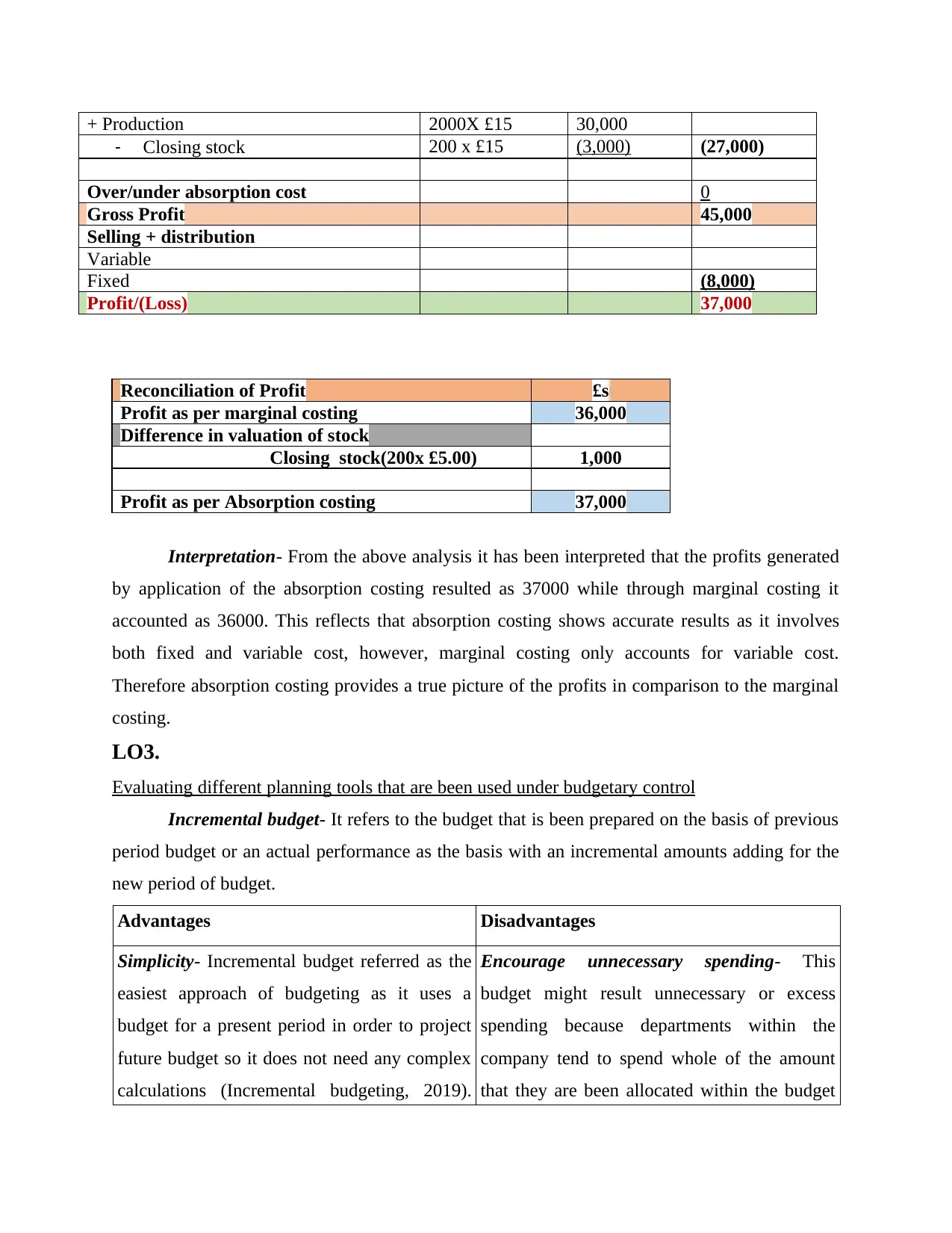
+ Production 2000X £15 30,000
- Closing stock 200 x £15 (3,000) (27,000)
Over/under absorption cost 0
Gross Profit 45,000
Selling + distribution
Variable
Fixed (8,000)
Profit/(Loss) 37,000
Reconciliation of Profit £s
Profit as per marginal costing 36,000
Difference in valuation of stock
Closing stock(200x £5.00) 1,000
Profit as per Absorption costing 37,000
Interpretation- From the above analysis it has been interpreted that the profits generated
by application of the absorption costing resulted as 37000 while through marginal costing it
accounted as 36000. This reflects that absorption costing shows accurate results as it involves
both fixed and variable cost, however, marginal costing only accounts for variable cost.
Therefore absorption costing provides a true picture of the profits in comparison to the marginal
costing.
LO3.
Evaluating different planning tools that are been used under budgetary control
Incremental budget- It refers to the budget that is been prepared on the basis of previous
period budget or an actual performance as the basis with an incremental amounts adding for the
new period of budget.
Advantages Disadvantages
Simplicity- Incremental budget referred as the
easiest approach of budgeting as it uses a
budget for a present period in order to project
future budget so it does not need any complex
calculations (Incremental budgeting, 2019).
Encourage unnecessary spending- This
budget might result unnecessary or excess
spending because departments within the
company tend to spend whole of the amount
that they are been allocated within the budget
- Closing stock 200 x £15 (3,000) (27,000)
Over/under absorption cost 0
Gross Profit 45,000
Selling + distribution
Variable
Fixed (8,000)
Profit/(Loss) 37,000
Reconciliation of Profit £s
Profit as per marginal costing 36,000
Difference in valuation of stock
Closing stock(200x £5.00) 1,000
Profit as per Absorption costing 37,000
Interpretation- From the above analysis it has been interpreted that the profits generated
by application of the absorption costing resulted as 37000 while through marginal costing it
accounted as 36000. This reflects that absorption costing shows accurate results as it involves
both fixed and variable cost, however, marginal costing only accounts for variable cost.
Therefore absorption costing provides a true picture of the profits in comparison to the marginal
costing.
LO3.
Evaluating different planning tools that are been used under budgetary control
Incremental budget- It refers to the budget that is been prepared on the basis of previous
period budget or an actual performance as the basis with an incremental amounts adding for the
new period of budget.
Advantages Disadvantages
Simplicity- Incremental budget referred as the
easiest approach of budgeting as it uses a
budget for a present period in order to project
future budget so it does not need any complex
calculations (Incremental budgeting, 2019).
Encourage unnecessary spending- This
budget might result unnecessary or excess
spending because departments within the
company tend to spend whole of the amount
that they are been allocated within the budget
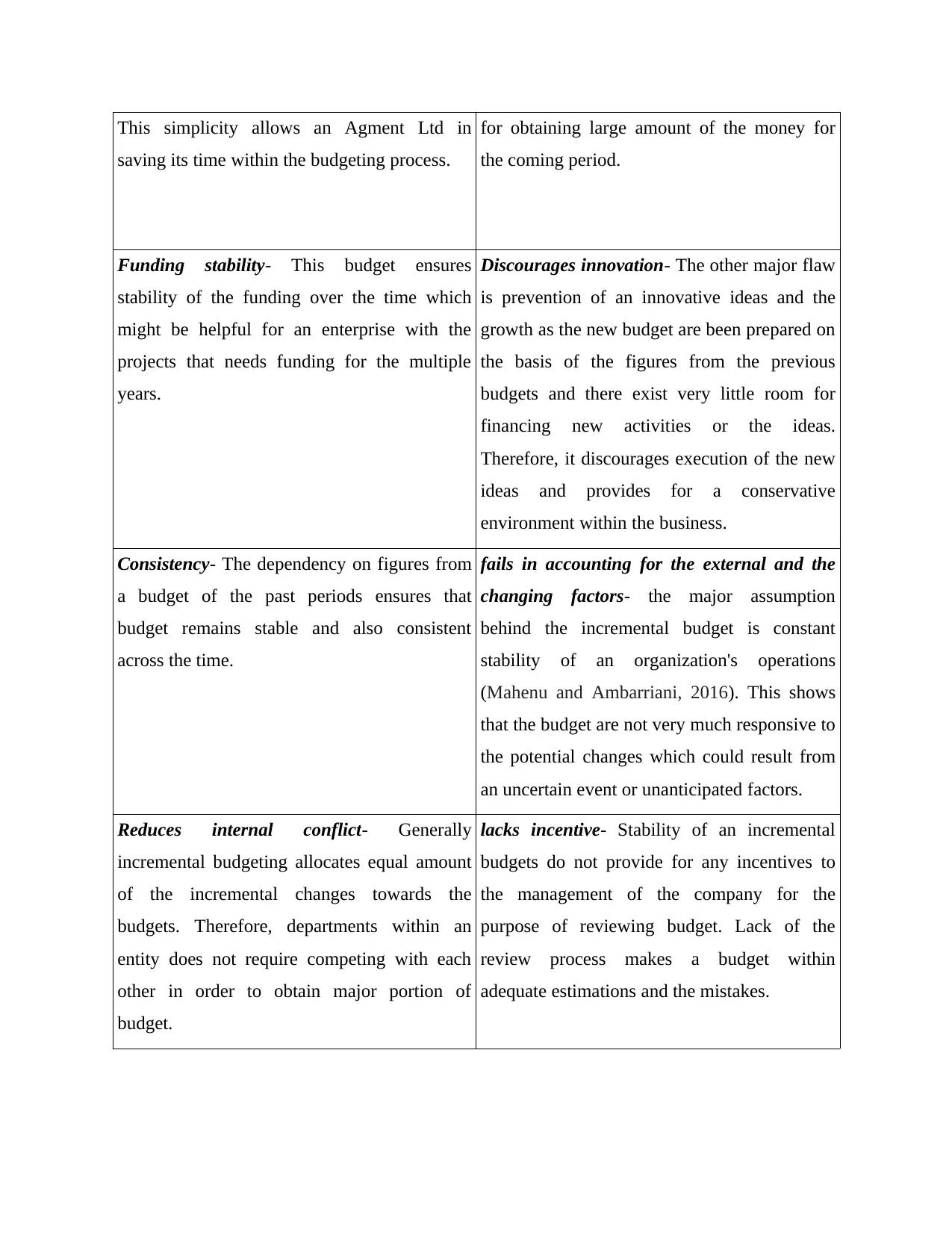
This simplicity allows an Agment Ltd in
saving its time within the budgeting process.
for obtaining large amount of the money for
the coming period.
Funding stability- This budget ensures
stability of the funding over the time which
might be helpful for an enterprise with the
projects that needs funding for the multiple
years.
Discourages innovation- The other major flaw
is prevention of an innovative ideas and the
growth as the new budget are been prepared on
the basis of the figures from the previous
budgets and there exist very little room for
financing new activities or the ideas.
Therefore, it discourages execution of the new
ideas and provides for a conservative
environment within the business.
Consistency- The dependency on figures from
a budget of the past periods ensures that
budget remains stable and also consistent
across the time.
fails in accounting for the external and the
changing factors- the major assumption
behind the incremental budget is constant
stability of an organization's operations
(Mahenu and Ambarriani, 2016). This shows
that the budget are not very much responsive to
the potential changes which could result from
an uncertain event or unanticipated factors.
Reduces internal conflict- Generally
incremental budgeting allocates equal amount
of the incremental changes towards the
budgets. Therefore, departments within an
entity does not require competing with each
other in order to obtain major portion of
budget.
lacks incentive- Stability of an incremental
budgets do not provide for any incentives to
the management of the company for the
purpose of reviewing budget. Lack of the
review process makes a budget within
adequate estimations and the mistakes.
saving its time within the budgeting process.
for obtaining large amount of the money for
the coming period.
Funding stability- This budget ensures
stability of the funding over the time which
might be helpful for an enterprise with the
projects that needs funding for the multiple
years.
Discourages innovation- The other major flaw
is prevention of an innovative ideas and the
growth as the new budget are been prepared on
the basis of the figures from the previous
budgets and there exist very little room for
financing new activities or the ideas.
Therefore, it discourages execution of the new
ideas and provides for a conservative
environment within the business.
Consistency- The dependency on figures from
a budget of the past periods ensures that
budget remains stable and also consistent
across the time.
fails in accounting for the external and the
changing factors- the major assumption
behind the incremental budget is constant
stability of an organization's operations
(Mahenu and Ambarriani, 2016). This shows
that the budget are not very much responsive to
the potential changes which could result from
an uncertain event or unanticipated factors.
Reduces internal conflict- Generally
incremental budgeting allocates equal amount
of the incremental changes towards the
budgets. Therefore, departments within an
entity does not require competing with each
other in order to obtain major portion of
budget.
lacks incentive- Stability of an incremental
budgets do not provide for any incentives to
the management of the company for the
purpose of reviewing budget. Lack of the
review process makes a budget within
adequate estimations and the mistakes.
Secure Best Marks with AI Grader
Need help grading? Try our AI Grader for instant feedback on your assignments.
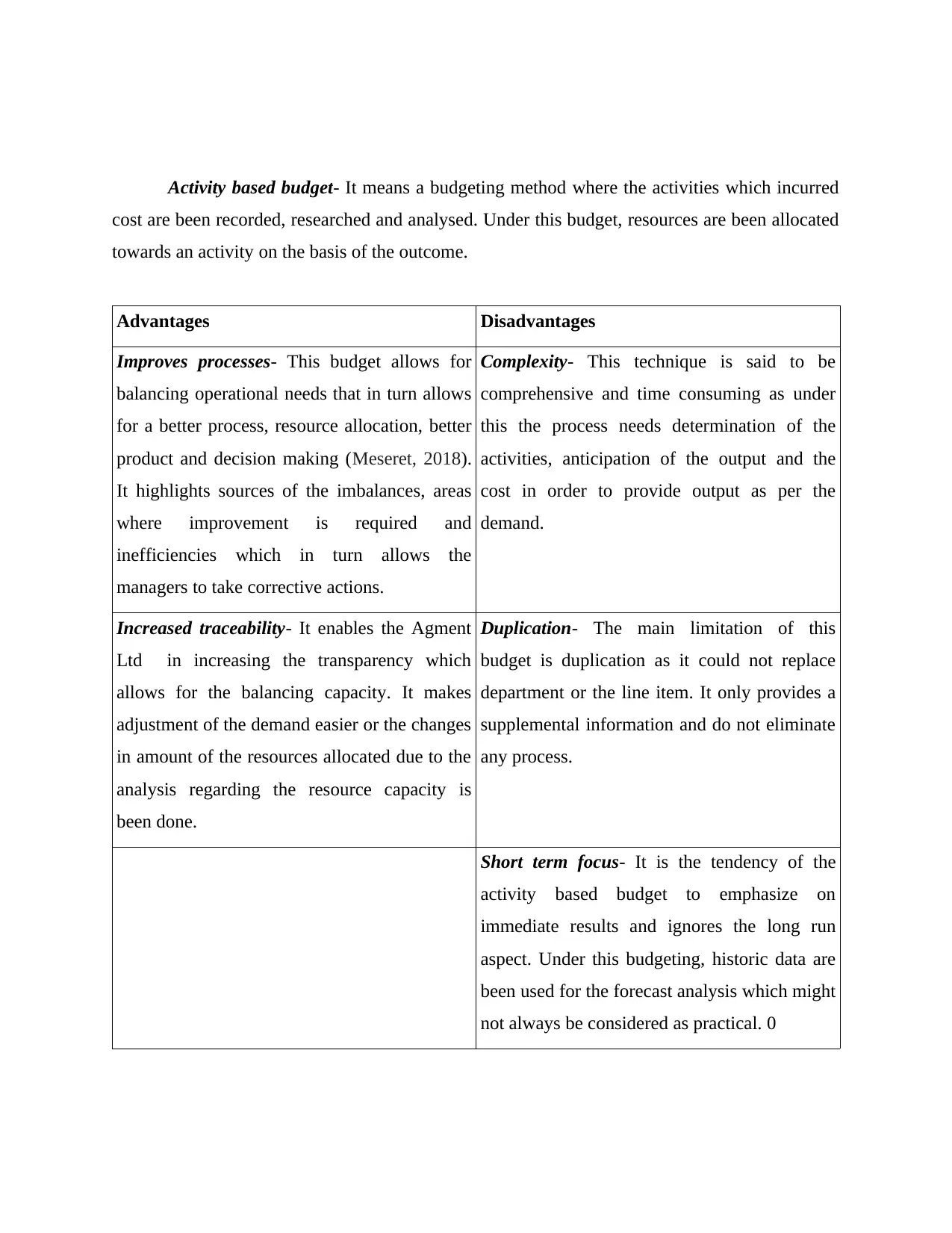
Activity based budget- It means a budgeting method where the activities which incurred
cost are been recorded, researched and analysed. Under this budget, resources are been allocated
towards an activity on the basis of the outcome.
Advantages Disadvantages
Improves processes- This budget allows for
balancing operational needs that in turn allows
for a better process, resource allocation, better
product and decision making (Meseret, 2018).
It highlights sources of the imbalances, areas
where improvement is required and
inefficiencies which in turn allows the
managers to take corrective actions.
Complexity- This technique is said to be
comprehensive and time consuming as under
this the process needs determination of the
activities, anticipation of the output and the
cost in order to provide output as per the
demand.
Increased traceability- It enables the Agment
Ltd in increasing the transparency which
allows for the balancing capacity. It makes
adjustment of the demand easier or the changes
in amount of the resources allocated due to the
analysis regarding the resource capacity is
been done.
Duplication- The main limitation of this
budget is duplication as it could not replace
department or the line item. It only provides a
supplemental information and do not eliminate
any process.
Short term focus- It is the tendency of the
activity based budget to emphasize on
immediate results and ignores the long run
aspect. Under this budgeting, historic data are
been used for the forecast analysis which might
not always be considered as practical. 0
cost are been recorded, researched and analysed. Under this budget, resources are been allocated
towards an activity on the basis of the outcome.
Advantages Disadvantages
Improves processes- This budget allows for
balancing operational needs that in turn allows
for a better process, resource allocation, better
product and decision making (Meseret, 2018).
It highlights sources of the imbalances, areas
where improvement is required and
inefficiencies which in turn allows the
managers to take corrective actions.
Complexity- This technique is said to be
comprehensive and time consuming as under
this the process needs determination of the
activities, anticipation of the output and the
cost in order to provide output as per the
demand.
Increased traceability- It enables the Agment
Ltd in increasing the transparency which
allows for the balancing capacity. It makes
adjustment of the demand easier or the changes
in amount of the resources allocated due to the
analysis regarding the resource capacity is
been done.
Duplication- The main limitation of this
budget is duplication as it could not replace
department or the line item. It only provides a
supplemental information and do not eliminate
any process.
Short term focus- It is the tendency of the
activity based budget to emphasize on
immediate results and ignores the long run
aspect. Under this budgeting, historic data are
been used for the forecast analysis which might
not always be considered as practical. 0
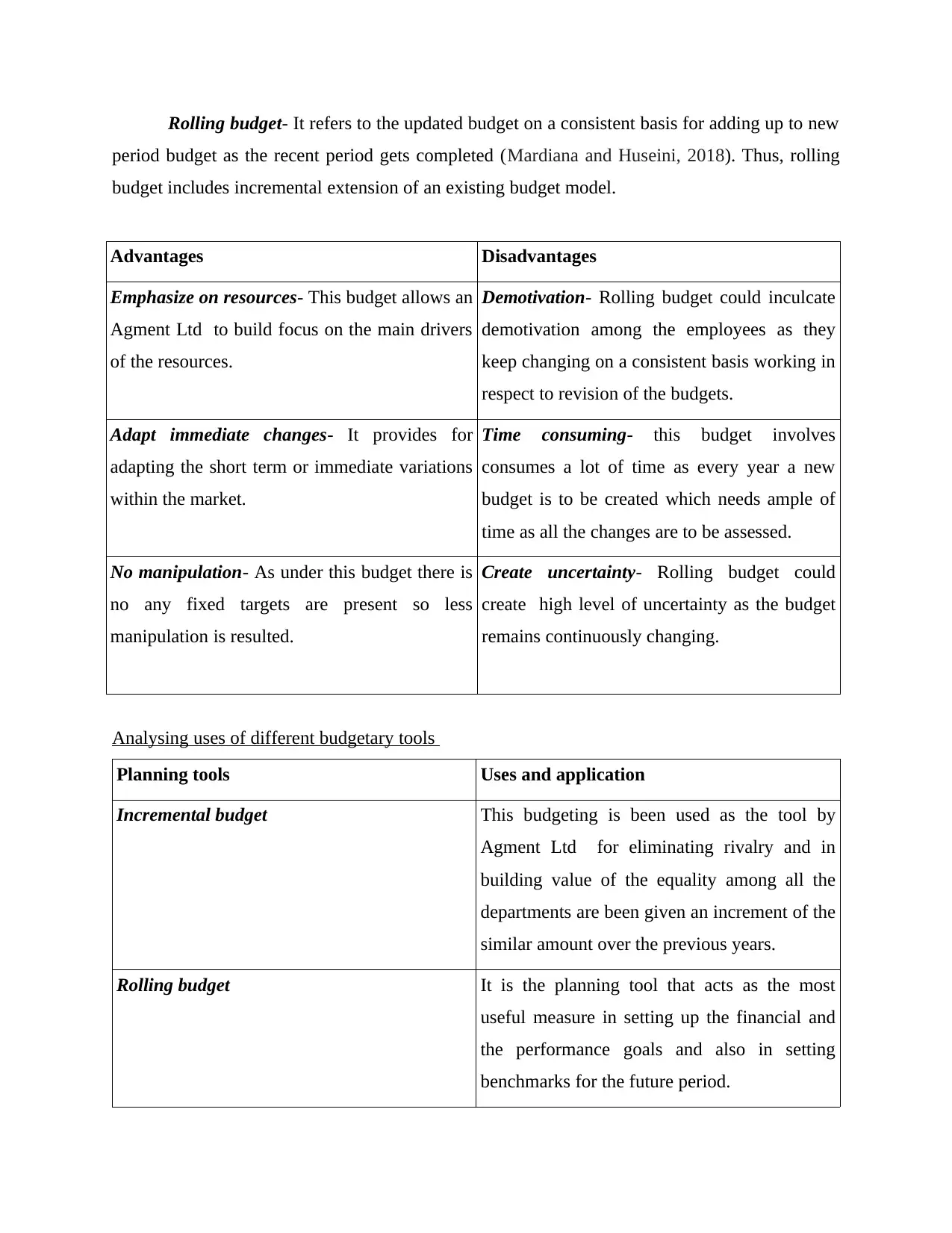
Rolling budget- It refers to the updated budget on a consistent basis for adding up to new
period budget as the recent period gets completed (Mardiana and Huseini, 2018). Thus, rolling
budget includes incremental extension of an existing budget model.
Advantages Disadvantages
Emphasize on resources- This budget allows an
Agment Ltd to build focus on the main drivers
of the resources.
Demotivation- Rolling budget could inculcate
demotivation among the employees as they
keep changing on a consistent basis working in
respect to revision of the budgets.
Adapt immediate changes- It provides for
adapting the short term or immediate variations
within the market.
Time consuming- this budget involves
consumes a lot of time as every year a new
budget is to be created which needs ample of
time as all the changes are to be assessed.
No manipulation- As under this budget there is
no any fixed targets are present so less
manipulation is resulted.
Create uncertainty- Rolling budget could
create high level of uncertainty as the budget
remains continuously changing.
Analysing uses of different budgetary tools
Planning tools Uses and application
Incremental budget This budgeting is been used as the tool by
Agment Ltd for eliminating rivalry and in
building value of the equality among all the
departments are been given an increment of the
similar amount over the previous years.
Rolling budget It is the planning tool that acts as the most
useful measure in setting up the financial and
the performance goals and also in setting
benchmarks for the future period.
period budget as the recent period gets completed (Mardiana and Huseini, 2018). Thus, rolling
budget includes incremental extension of an existing budget model.
Advantages Disadvantages
Emphasize on resources- This budget allows an
Agment Ltd to build focus on the main drivers
of the resources.
Demotivation- Rolling budget could inculcate
demotivation among the employees as they
keep changing on a consistent basis working in
respect to revision of the budgets.
Adapt immediate changes- It provides for
adapting the short term or immediate variations
within the market.
Time consuming- this budget involves
consumes a lot of time as every year a new
budget is to be created which needs ample of
time as all the changes are to be assessed.
No manipulation- As under this budget there is
no any fixed targets are present so less
manipulation is resulted.
Create uncertainty- Rolling budget could
create high level of uncertainty as the budget
remains continuously changing.
Analysing uses of different budgetary tools
Planning tools Uses and application
Incremental budget This budgeting is been used as the tool by
Agment Ltd for eliminating rivalry and in
building value of the equality among all the
departments are been given an increment of the
similar amount over the previous years.
Rolling budget It is the planning tool that acts as the most
useful measure in setting up the financial and
the performance goals and also in setting
benchmarks for the future period.

Activity based budget It is the system that is been used by an
enterprise in analysing activities that are
leading to cost within the business. This
budgetary tool works by dividing the cost in
accordance to activities that the company
requires to carry out for running its operations
smoothly.
LO4.
Comparing the use of different MA systems by the firm in order to respond the financial
problems
Balanced scorecard- It refers to the performance metric that relates to strategic
management and is used by the firm for identifying and improving several internal functions of
the business and its resulting outcome. This measure used fro measuring and facilitating the
feedback to an organization. As this approach provides a broader view of the major perspectives
such as customer, financial, internal process, growth outcome etc., an entity could be able to
resolve its financial problem in relation to raising the funds through the best sources and meeting
the demand of the customer.
Benchmarking- It is the practice of assessing performance of an entity's products,
services and the processes with that of the another business or rivalry for being the best within an
entire industry. This technique helps in identifying the internal opportunities for achieving
improvement (Kocmanova, A. and et.al., 2017). With the use of this tool Agment Ltd could be
able to attain competitive edge and overcome the financial problem regarding less profitability.
Key performance indicator- This MA tool stated as the measurable value which
demonstrates effectiveness of Agment Ltd in reaching its business objectives. For evaluating the
success, enterprise make use of KPI so that it could be able to reach its target efficiently and
effectively. It helps the company in overcoming its financial problem regarding measurement of
the success and in meeting the targets on time.
variance analysis- It means the study of the deviation that resulted in between the actual
and the standard budget. It acts as an analytical tool that helps in comparing the actual operation
of the firm with its budgeted operations. This tool enables the company in taking the appropriate
enterprise in analysing activities that are
leading to cost within the business. This
budgetary tool works by dividing the cost in
accordance to activities that the company
requires to carry out for running its operations
smoothly.
LO4.
Comparing the use of different MA systems by the firm in order to respond the financial
problems
Balanced scorecard- It refers to the performance metric that relates to strategic
management and is used by the firm for identifying and improving several internal functions of
the business and its resulting outcome. This measure used fro measuring and facilitating the
feedback to an organization. As this approach provides a broader view of the major perspectives
such as customer, financial, internal process, growth outcome etc., an entity could be able to
resolve its financial problem in relation to raising the funds through the best sources and meeting
the demand of the customer.
Benchmarking- It is the practice of assessing performance of an entity's products,
services and the processes with that of the another business or rivalry for being the best within an
entire industry. This technique helps in identifying the internal opportunities for achieving
improvement (Kocmanova, A. and et.al., 2017). With the use of this tool Agment Ltd could be
able to attain competitive edge and overcome the financial problem regarding less profitability.
Key performance indicator- This MA tool stated as the measurable value which
demonstrates effectiveness of Agment Ltd in reaching its business objectives. For evaluating the
success, enterprise make use of KPI so that it could be able to reach its target efficiently and
effectively. It helps the company in overcoming its financial problem regarding measurement of
the success and in meeting the targets on time.
variance analysis- It means the study of the deviation that resulted in between the actual
and the standard budget. It acts as an analytical tool that helps in comparing the actual operation
of the firm with its budgeted operations. This tool enables the company in taking the appropriate
Paraphrase This Document
Need a fresh take? Get an instant paraphrase of this document with our AI Paraphraser
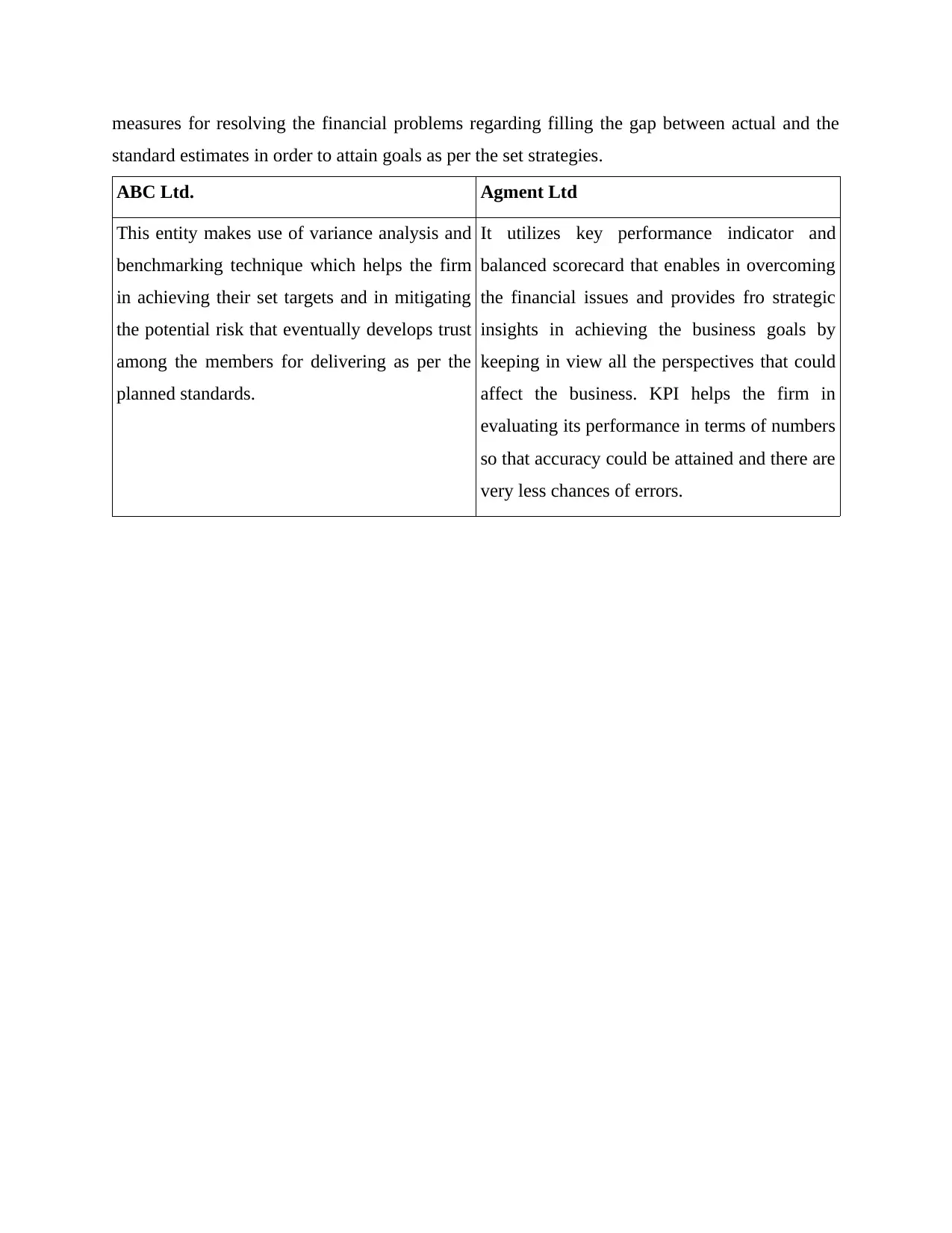
measures for resolving the financial problems regarding filling the gap between actual and the
standard estimates in order to attain goals as per the set strategies.
ABC Ltd. Agment Ltd
This entity makes use of variance analysis and
benchmarking technique which helps the firm
in achieving their set targets and in mitigating
the potential risk that eventually develops trust
among the members for delivering as per the
planned standards.
It utilizes key performance indicator and
balanced scorecard that enables in overcoming
the financial issues and provides fro strategic
insights in achieving the business goals by
keeping in view all the perspectives that could
affect the business. KPI helps the firm in
evaluating its performance in terms of numbers
so that accuracy could be attained and there are
very less chances of errors.
standard estimates in order to attain goals as per the set strategies.
ABC Ltd. Agment Ltd
This entity makes use of variance analysis and
benchmarking technique which helps the firm
in achieving their set targets and in mitigating
the potential risk that eventually develops trust
among the members for delivering as per the
planned standards.
It utilizes key performance indicator and
balanced scorecard that enables in overcoming
the financial issues and provides fro strategic
insights in achieving the business goals by
keeping in view all the perspectives that could
affect the business. KPI helps the firm in
evaluating its performance in terms of numbers
so that accuracy could be attained and there are
very less chances of errors.

CONCLUSION
By summing up the above study it has been indicated that management accounting plays
a significant role in the routine activities of the business with respect to setting up the strategies,
performance, cost incurred in producing the goods of Agmet Ltd. MA systems helps the
company in attaining growing success for the future periods with ensuring prpoer control over
the cost so that higher profitability could be achieved. Similarly budgetary tools helps in
responding towards the financial problems and in enhancing the financial performance and the
position of an enterprise.
By summing up the above study it has been indicated that management accounting plays
a significant role in the routine activities of the business with respect to setting up the strategies,
performance, cost incurred in producing the goods of Agmet Ltd. MA systems helps the
company in attaining growing success for the future periods with ensuring prpoer control over
the cost so that higher profitability could be achieved. Similarly budgetary tools helps in
responding towards the financial problems and in enhancing the financial performance and the
position of an enterprise.
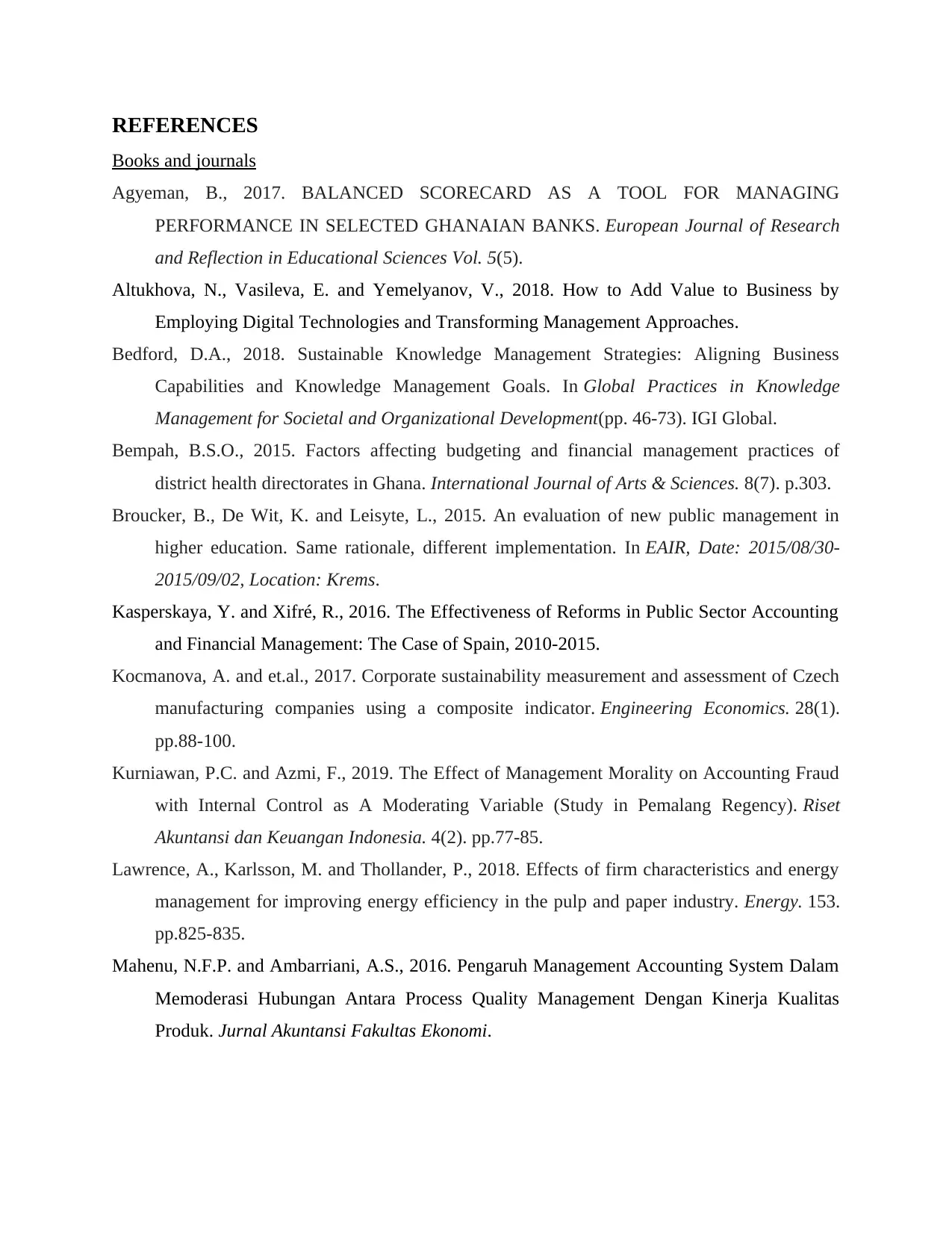
REFERENCES
Books and journals
Agyeman, B., 2017. BALANCED SCORECARD AS A TOOL FOR MANAGING
PERFORMANCE IN SELECTED GHANAIAN BANKS. European Journal of Research
and Reflection in Educational Sciences Vol. 5(5).
Altukhova, N., Vasileva, E. and Yemelyanov, V., 2018. How to Add Value to Business by
Employing Digital Technologies and Transforming Management Approaches.
Bedford, D.A., 2018. Sustainable Knowledge Management Strategies: Aligning Business
Capabilities and Knowledge Management Goals. In Global Practices in Knowledge
Management for Societal and Organizational Development(pp. 46-73). IGI Global.
Bempah, B.S.O., 2015. Factors affecting budgeting and financial management practices of
district health directorates in Ghana. International Journal of Arts & Sciences. 8(7). p.303.
Broucker, B., De Wit, K. and Leisyte, L., 2015. An evaluation of new public management in
higher education. Same rationale, different implementation. In EAIR, Date: 2015/08/30-
2015/09/02, Location: Krems.
Kasperskaya, Y. and Xifré, R., 2016. The Effectiveness of Reforms in Public Sector Accounting
and Financial Management: The Case of Spain, 2010-2015.
Kocmanova, A. and et.al., 2017. Corporate sustainability measurement and assessment of Czech
manufacturing companies using a composite indicator. Engineering Economics. 28(1).
pp.88-100.
Kurniawan, P.C. and Azmi, F., 2019. The Effect of Management Morality on Accounting Fraud
with Internal Control as A Moderating Variable (Study in Pemalang Regency). Riset
Akuntansi dan Keuangan Indonesia. 4(2). pp.77-85.
Lawrence, A., Karlsson, M. and Thollander, P., 2018. Effects of firm characteristics and energy
management for improving energy efficiency in the pulp and paper industry. Energy. 153.
pp.825-835.
Mahenu, N.F.P. and Ambarriani, A.S., 2016. Pengaruh Management Accounting System Dalam
Memoderasi Hubungan Antara Process Quality Management Dengan Kinerja Kualitas
Produk. Jurnal Akuntansi Fakultas Ekonomi.
Books and journals
Agyeman, B., 2017. BALANCED SCORECARD AS A TOOL FOR MANAGING
PERFORMANCE IN SELECTED GHANAIAN BANKS. European Journal of Research
and Reflection in Educational Sciences Vol. 5(5).
Altukhova, N., Vasileva, E. and Yemelyanov, V., 2018. How to Add Value to Business by
Employing Digital Technologies and Transforming Management Approaches.
Bedford, D.A., 2018. Sustainable Knowledge Management Strategies: Aligning Business
Capabilities and Knowledge Management Goals. In Global Practices in Knowledge
Management for Societal and Organizational Development(pp. 46-73). IGI Global.
Bempah, B.S.O., 2015. Factors affecting budgeting and financial management practices of
district health directorates in Ghana. International Journal of Arts & Sciences. 8(7). p.303.
Broucker, B., De Wit, K. and Leisyte, L., 2015. An evaluation of new public management in
higher education. Same rationale, different implementation. In EAIR, Date: 2015/08/30-
2015/09/02, Location: Krems.
Kasperskaya, Y. and Xifré, R., 2016. The Effectiveness of Reforms in Public Sector Accounting
and Financial Management: The Case of Spain, 2010-2015.
Kocmanova, A. and et.al., 2017. Corporate sustainability measurement and assessment of Czech
manufacturing companies using a composite indicator. Engineering Economics. 28(1).
pp.88-100.
Kurniawan, P.C. and Azmi, F., 2019. The Effect of Management Morality on Accounting Fraud
with Internal Control as A Moderating Variable (Study in Pemalang Regency). Riset
Akuntansi dan Keuangan Indonesia. 4(2). pp.77-85.
Lawrence, A., Karlsson, M. and Thollander, P., 2018. Effects of firm characteristics and energy
management for improving energy efficiency in the pulp and paper industry. Energy. 153.
pp.825-835.
Mahenu, N.F.P. and Ambarriani, A.S., 2016. Pengaruh Management Accounting System Dalam
Memoderasi Hubungan Antara Process Quality Management Dengan Kinerja Kualitas
Produk. Jurnal Akuntansi Fakultas Ekonomi.
Secure Best Marks with AI Grader
Need help grading? Try our AI Grader for instant feedback on your assignments.
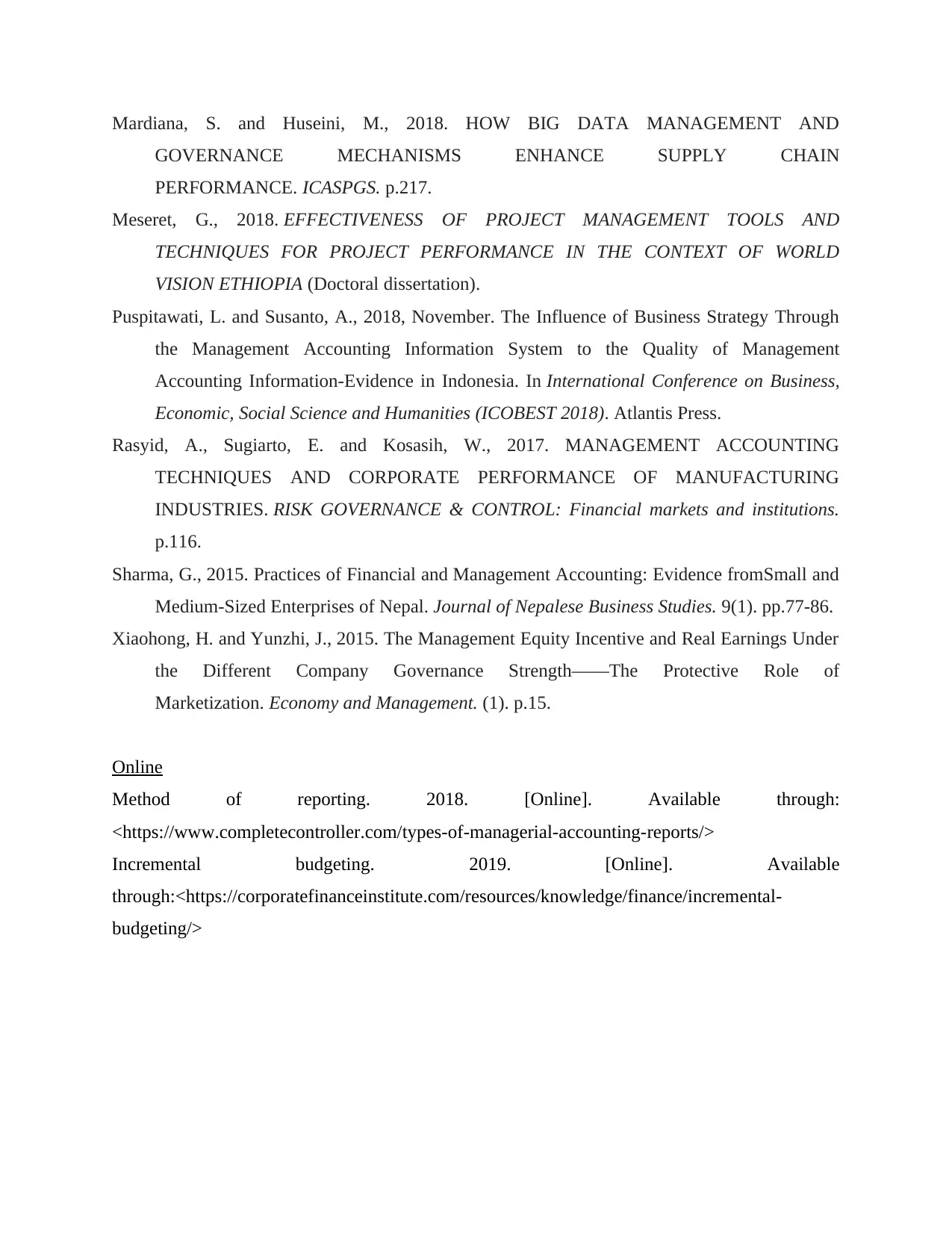
Mardiana, S. and Huseini, M., 2018. HOW BIG DATA MANAGEMENT AND
GOVERNANCE MECHANISMS ENHANCE SUPPLY CHAIN
PERFORMANCE. ICASPGS. p.217.
Meseret, G., 2018. EFFECTIVENESS OF PROJECT MANAGEMENT TOOLS AND
TECHNIQUES FOR PROJECT PERFORMANCE IN THE CONTEXT OF WORLD
VISION ETHIOPIA (Doctoral dissertation).
Puspitawati, L. and Susanto, A., 2018, November. The Influence of Business Strategy Through
the Management Accounting Information System to the Quality of Management
Accounting Information-Evidence in Indonesia. In International Conference on Business,
Economic, Social Science and Humanities (ICOBEST 2018). Atlantis Press.
Rasyid, A., Sugiarto, E. and Kosasih, W., 2017. MANAGEMENT ACCOUNTING
TECHNIQUES AND CORPORATE PERFORMANCE OF MANUFACTURING
INDUSTRIES. RISK GOVERNANCE & CONTROL: Financial markets and institutions.
p.116.
Sharma, G., 2015. Practices of Financial and Management Accounting: Evidence fromSmall and
Medium-Sized Enterprises of Nepal. Journal of Nepalese Business Studies. 9(1). pp.77-86.
Xiaohong, H. and Yunzhi, J., 2015. The Management Equity Incentive and Real Earnings Under
the Different Company Governance Strength——The Protective Role of
Marketization. Economy and Management. (1). p.15.
Online
Method of reporting. 2018. [Online]. Available through:
<https://www.completecontroller.com/types-of-managerial-accounting-reports/>
Incremental budgeting. 2019. [Online]. Available
through:<https://corporatefinanceinstitute.com/resources/knowledge/finance/incremental-
budgeting/>
GOVERNANCE MECHANISMS ENHANCE SUPPLY CHAIN
PERFORMANCE. ICASPGS. p.217.
Meseret, G., 2018. EFFECTIVENESS OF PROJECT MANAGEMENT TOOLS AND
TECHNIQUES FOR PROJECT PERFORMANCE IN THE CONTEXT OF WORLD
VISION ETHIOPIA (Doctoral dissertation).
Puspitawati, L. and Susanto, A., 2018, November. The Influence of Business Strategy Through
the Management Accounting Information System to the Quality of Management
Accounting Information-Evidence in Indonesia. In International Conference on Business,
Economic, Social Science and Humanities (ICOBEST 2018). Atlantis Press.
Rasyid, A., Sugiarto, E. and Kosasih, W., 2017. MANAGEMENT ACCOUNTING
TECHNIQUES AND CORPORATE PERFORMANCE OF MANUFACTURING
INDUSTRIES. RISK GOVERNANCE & CONTROL: Financial markets and institutions.
p.116.
Sharma, G., 2015. Practices of Financial and Management Accounting: Evidence fromSmall and
Medium-Sized Enterprises of Nepal. Journal of Nepalese Business Studies. 9(1). pp.77-86.
Xiaohong, H. and Yunzhi, J., 2015. The Management Equity Incentive and Real Earnings Under
the Different Company Governance Strength——The Protective Role of
Marketization. Economy and Management. (1). p.15.
Online
Method of reporting. 2018. [Online]. Available through:
<https://www.completecontroller.com/types-of-managerial-accounting-reports/>
Incremental budgeting. 2019. [Online]. Available
through:<https://corporatefinanceinstitute.com/resources/knowledge/finance/incremental-
budgeting/>

1 out of 18
Related Documents
Your All-in-One AI-Powered Toolkit for Academic Success.
+13062052269
info@desklib.com
Available 24*7 on WhatsApp / Email
![[object Object]](/_next/static/media/star-bottom.7253800d.svg)
Unlock your academic potential
© 2024 | Zucol Services PVT LTD | All rights reserved.





